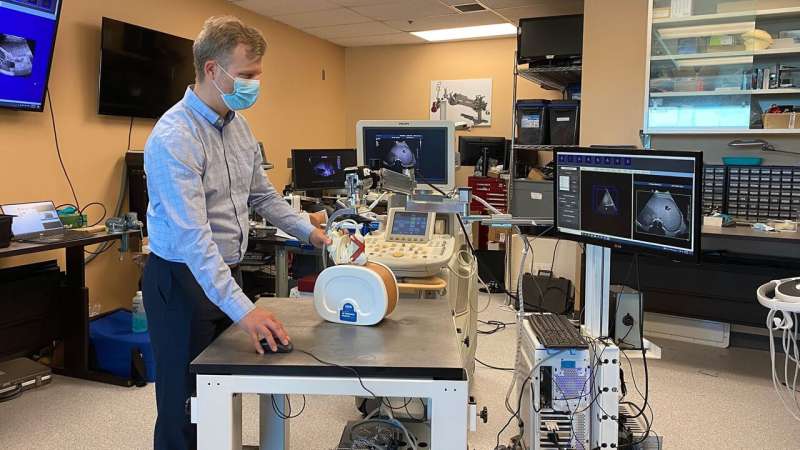This article has been reviewed according to Science X's editorial process and policies. Editors have highlighted the following attributes while ensuring the content's credibility:
fact-checked
trusted source
proofread
New 3D ultrasound may improve accuracy of liver cancer treatment

A simulated study by researchers at Western University and Lawson Health Research Institute has found a new system that uses ultrasound to construct 3D-images could make treatment of liver cancer, using thermal ablation, more accurate.
Liver cancer is among the leading causes of cancer death globally. While surgery is one treatment option, thermal ablation—using heat to destroy the cancerous tumor—can have fewer complications and a shorter recovery time. It can also be used for patients who are not surgical candidates for various reasons. Thermal ablation also requires precise needle placement to treat the cancer without damaging the vital organs and blood vessels around it.
"It's very important that we get the needle right in the center of the tumor," said Dr. Derek Cool, professor at Schulich School of Medicine & Dentistry, associate scientist at Lawson and interventional radiologist at London Health Sciences Center (LHSC). "If the treatment area doesn't fully cover the tumor, patients are left with a small amount of residual cancer, risking recurrence and the need for additional treatment."
Ultrasound or CT (computerized tomography) imaging is normally used to guide needle placement, but both are limited. Ultrasound is widely available and can be done in real-time, but only delivers a 2D image. While a CT scan provides a 3D image, it isn't in real time and can be a lengthy process.
"We developed a new 3D ultrasound method that shows promise in analyzing whether the complete liver tumor will be ablated by the procedure," explained Aaron Fenster, professor at Schulich Medicine & Dentistry and scientist at Robarts Research Institute. "And we're now using the same system to guide the needle directly into the center of the tumor."
To create the 3D ultrasound images, a robotic cradle moves a standard ultrasound probe, collecting images and stacking them like puzzle pieces.
The simulated study, published in IEEE Transactions on Medical Imaging, used data from 14 patient cases at LHSC to analyze accuracy of the technology. It found that with standard imaging, 64.3 percent of cases showed complete tumor ablation, while the new system could result in complete coverage for 92.9 percent of cases (13 of 14 cases). The researchers found that the one remaining case could benefit from increasing the ablation time or intensity.
"Our next step is to move from simulation studies to a clinical trial," said Cool.
If proven effective, the robotic ultrasound system's portability could potentially allow for more widespread use of 3D ultrasound imaging, including in smaller health-care centers. By eliminating the need for CT scans, it could also help to reduce imaging wait times.
"If a clinical trial shows the approach is more accurate and more precise than conventional techniques, there would be a direct impact on patient care," said Fenster. "We hope to explore commercialization to license the technology and distribute it worldwide."
More information: Shuwei Xing et al, 3D US-Based Evaluation and Optimization of Tumor Coverage for US-Guided Percutaneous Liver Thermal Ablation, IEEE Transactions on Medical Imaging (2022). DOI: 10.1109/TMI.2022.3184334




















